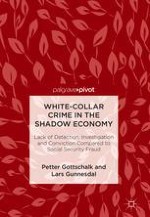Fraction of White-Collar Criminals
Fraction with Probability Distribution
Fraction of Offender Groups
Approach 3: Type of white-collar offender | ||||
|---|---|---|---|---|
Figures from our database | Student’s estimate | |||
Level of white-collar criminals | Fraction of population (%) | Crime amount (million NOK) | Fraction convicted (%) | Sum of money (billion NOK) |
Top level
| 28.4 | 33.0 | 12.5 | 4.8 |
Middle level
| 46.1 | 16.6 | 12.7 | 3.9 |
Basic level
| 25.5 | 9.7 | 13.2 | 1.3 |
Total
|
100
|
10.0
| ||
Fraction of Crime Categories
Approach 4: Type of white-collar crime | ||||
|---|---|---|---|---|
Figures from our database | Student’s estimate | |||
Category of white-collar crime | Fraction of population (%) | Crime amount (million NOK) | Fraction convicted (%) | Sum of money (billion NOK) |
Fraud
| 42.6 | 25.4 | 15.8 | 4.4 |
Theft
| 4.2 | 4.8 | 17.0 | 0.1 |
Manipulation
| 35.3 | 22.8 | 13.2 | 3.9 |
Corruption
| 17.9 | 2.5 | 16.9 | 0.2 |
Total
|
100
|
8.6
| ||
Fraction of Victim Groups
Approach 5: Type of victim | ||||
|---|---|---|---|---|
Figures from our database | Student’s estimate | |||
Category of white-collar crime victim | Fraction of population (%) | Crime amount (million NOK) | Fraction convicted (%) | Sum of money (billion NOK) |
Employer
| 27.9 | 8.7 | 14.8 | 1.1 |
Banks
| 14.2 | 49.5 | 17.2 | 2.6 |
Tax authority
| 22.1 | 18.0 | 16.2 | 1.7 |
Customers
| 16.4 | 17.3 | 14.3 | 1.3 |
Shareholders
| 7.4 | 29.8 | 15.2 | 0.9 |
Others
| 12.0 | 6.9 | 13.5 | 0.4 |
Total
|
100
|
8.0
| ||
Gender Fractions
Approach 6: Gender of white-collar criminal | ||||
|---|---|---|---|---|
Figures from our database | Student’s estimate | |||
Category of white-collar crime victim | Fraction of population (%) | Crime amount (million NOK) | Fraction convicted (%) | Sum of money (billion NOK) |
Women
| 7.6 | 9.0 | 8.7 | 0.5 |
Men
| 92.4 | 20.4 | 18.7 | 6.5 |
Total
|
100
|
7.0
| ||
Total Crime Magnitude
All approaches combined | |
|---|---|
Approach | Student’s estimate (billion NOK) |
1
| 9.3 |
2
| – |
3
| 10.0 |
4
| 8.6 |
5
| 8.0 |
6
| 7.0 |
7
| (90.7) |
Average
|
8.5
|
Expert–Student Comparison
Experts (%) | Students (%) | |
|---|---|---|
Lack of detection | 59 | 15 |
Lack of investigation | 19 | 29 |
Lack of prosecution | 8 | 24 |
Lack of conviction | 5 | 19 |
Convictions | 9 | 13 |
Total | 100 | 100 |
